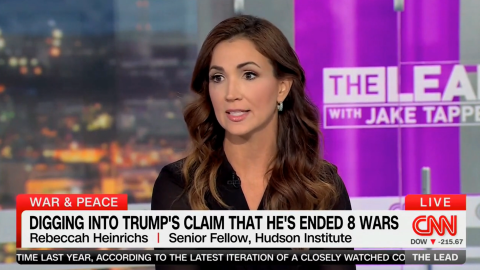It is an often-repeated truism that the greatest strength of the US is its network of alliances. This network, cultivated over decades, persists not as a mere vestige of a bygone era, but due to a conscious recognition that these unions on balance provide net benefits to the US. Chief amongst this network of alliances is NATO, which, despite its flaws, has accomplished and continues to fulfil its fundamental mission to ‘promote stability and well-being in the North Atlantic area’ (NATO 1949).
The fundamental position that NATO occupies in ensuring the continued peace and prosperity of the US has, in the past, helped moderate nascent calls for disengagement from European security structures. The importance of a stable Europe for continued US prosperity is evidenced by the fact that over half of the country’s cumulative inward foreign direct investment comes from Europe (Global Business Alliance 2024). In 2023, of the top 10 countries of origin for inbound foreign direct investment (as calculated by country of ultimate beneficial owner), 7 were European (Bureau of Economic Analysis 2024, 10).
In addition to economic and security benefits, historical ties to Europe and public opinion broadly sympathetic to continued US involvement in European security buffer more radical shifts in policy across presidential administrations. A 2024 survey which found that over three-quarters of Americans support, at minimum, maintaining current US commitments to NATO is illustrative of a consistent bedrock of public support (Friedhoff and Smeltz 2024). Another example is the significant level of backing amongst the public in the US for maintaining US bases overseas and the use of the country’s troops to defend allies, support which exists across the political spectrum (Friedhoff 2024). Isolationism remains the lonely outpost of a select number of elites, with the bulk of the public and policymakers still in favour of a US role in the world. While US foreign policy over the past two decades has tended to see strong shifts across administrations in focus areas such as energy or policy on Iran, the centrality of the European theatre and NATO for US engagement overseas has served as a ballast to steady the nation’s overall approach.
The Trump approach
The second Trump administration is less instinctually supportive of an expansive role overseas than the president’s immediate predecessors. Donald Trump’s return to office has therefore ushered in changes which will impact the transatlantic alliance to a greater degree than has been seen in the recent past. It should be noted that it is not yet clear how much staying power these changes will have beyond the current administration. US policy may snap back towards its more traditional Eurocentric focus, but that is not assured.
Whether explicitly stated or not, the Trump administration’s foreign policy calculus is shaped by two fundamental beliefs. The first is that the world has morphed into multipolarity, and the unipolar moment is either irretrievable or not worth the investment to recapture. The second is that US debt, northwards of $36 trillion, is a fundamental risk to the nation’s continued innovation and prosperity, and, as such, requires a paring back of US engagement overseas. Over the next four years, US foreign policy will focus resources on areas perceived by the administration to be of core interest to the nation while engaging less with those perceived to be more expendable.
The Trump administration has telegraphed that it will concentrate on the realities of hard power and that it desires swiftness of decision and action over lengthy process and policy formulation. While there is much consternation in many corners of Europe over early changes in US policy, Europe retains the agency to shape the administration’s approach to the transatlantic alliance and should seek to build itself into a strong pole, yet to do so within the context of existing NATO structures. Europe would do well to speed up its own decision-making processes and present options to the Trump administration which could satisfy interests on both sides of the Atlantic.
For the US, NATO and the continued functioning of alliance deterrence will remain a core interest. In his remarks to the Ukraine Defense Contact Group in February, Defense Secretary Hegseth reiterated this point, stating, ‘The United States remains committed to the NATO alliance and to the defense partnership with Europe. Full stop’ (Hegseth 2025). Likewise, Secretary of State Rubio clearly confirmed the US’s continued commitment to NATO. US policy on NATO in the second Trump administration will focus heavily on catalysing the rebuilding of allied war-fighting capabilities while decreasing reliance on US hard power (US Department of State, Office of the Spokesperson 2025). The language around why the US remains involved in NATO will focus on security benefits rather than speaking to the values-based components of the mutual alliance.
It should come as no surprise that pushing for increased defence investment will continue to be a prominent feature of US engagement with NATO in the second Trump term. Here, there has been considerable progress over the past decade, particularly since the commencement of Russia’s full-scale invasion of Ukraine. Last year, 23 of the 32 NATO member states spent a minimum of 2% of GDP on defence, with only 2 allies failing to spend 20% of their defence expenditure on new equipment (NATO 2024). In 2018 those numbers were 7 and 16, respectively (NATO 2019). The Trump administration has called for increasing the alliance benchmark for defence spending, with President Trump suggesting 5% as a potential target (Gray and Bayer 2025). While 5% is unlikely to win agreement as the new NATO standard, US advocacy is based upon a recognition that NATO finds itself with significant vulnerabilities, particularly in the realms of air defence (Foy and Rathbone 2024), long-range missiles and military recruitment in many countries (Kayali and Posaner 2024).
Allied leaders are moving steadily towards the US position. Polish Prime Minister Tusk has affirmed his support for the 5% benchmark (DW 2025). Denmark announced further increases in defence spending, which will result in the country spending more than 3% of its GDP in 2025 and 2026 (AP News 2025). In January French President Macron wondered aloud whether the country’s military spending was ‘enough to achieve the mass, depth and innovation to defend ourselves in a major confrontation’ (Kayali 2025). That same month, the European Commission’s Vice-President Kallas stated that Europe needs to prioritise defence spending even if that means cutting education and healthcare (Clash Report 2025). NATO Secretary General Rutte has stated that 2% ‘is not nearly enough to stay safe in the years to come’ (Soler 2025).
Despite the acute threat facing the alliance, NATO is politically unified and clear-eyed about the risks confronting the transatlantic community, although reactions have varied. In 2023 the Supreme Allied Commander Europe stated, ‘This is the first time in more than 30 years that we have an objective plans-based statement of requirements. And that is a real advantage for all nations in the alliance. It will give focus to their national defense planning for collective defense purposes’ (Kenney 2023). The need for greater European military capabilities is heightened by the likely implementation of a policy of Pacific prioritisation under the Trump administration. This policy is expected to entail a military focus on the Indo-Pacific rather than the Atlantic, with the goal of establishing a dichotomy of responsibility: Europeans chiefly maintaining security in their home theatre and the US taking the lead on security in the Indo-Pacific.
Pacific prioritisation
Pacific prioritisation seeks to offload hard power responsibilities within NATO onto European allies in order to manage a shrinking pool of US capabilities in anticipation of a hot contingency in the Indo-Pacific, as well as perceived threats to the homeland. The open question is to what degree the US will withdraw resources from the European theatre and, if withdrawals occur, how swift the timetable will be. Reports that Trump aims to withdraw 20,000 US troops from Europe, if accurate, are an early indication that the administration will pursue a policy of prioritisation away from Europe (Vandiver 2025).
This outcome is likely but not set in stone or fully fleshed out. In February, when asked about the possibility of withdrawing US forces from Europe, Trump stated, ‘No one is asking for that, so I do not think we will have to. I would not want to do that’ (New Voice of Ukraine 2025). Furthermore, after meeting with the US special envoy for Ukraine and Russia, Keith Kellogg, in February, Polish President Andryzej Duda stated, ‘There are absolutely no American intentions to reduce activity in our part of Europe, especially in terms of security, or to decrease the number of American troops’ (Krzysztoszek 2025). It is worth recalling that the Obama administration’s ‘pivot to Asia’ policy was rhetorical: until Russia invaded Crimea, the US removed assets from Europe but did not reapportion those assets to the Indo-Pacific theatre. Similarly, while Pacific prioritisation arguments gained some modest currency in the first Trump administration, they were never put into practice with any effect.
Europe is likely to see either a drawdown of the US military presence in the theatre, a redistribution of US forces inside Europe or some combination of the two. The US will seek to remain NATO’s guarantor of last resort while playing a diminished role in contributing front-line capabilities. The US defence secretary clearly outlined this policy in February, saying, ‘The US is prioritizing deterring war with China in the Pacific, recognizing the reality of scarcity, and making the resourcing trade-offs to ensure deterrence does not fail’ (Hegseth 2025). The Trump administration believes it cannot wait any longer to bolster its defences in the Indo-Pacific and is out of patience with European nations promising action on defence but continuing to dither on delivering capabilities. For the administration, the policy of prioritising the Pacific would, in turn, ideally serve the forceful function of motivating Europe to fill in the gaps a US drawdown would inevitably expose. NATO planners are already redesigning alliance defence plans to account for this likely shift in US policy (Detsch et al. 2025).
While the US remains the most important actor within NATO, US presence in Europe, in historical terms, today remains quite modest (Kochis 2024b). In my view, a policy of Pacific prioritisation is not advisable (Kochis 2024b); the conditions for the pathway of large-scale US removal from Europe are not in place (namely that Europe could defend itself) and are unlikely to be in the near future. However, if this course is pursued, as is likely, the administration will need to calibrate the drawdown of US assets in Europe carefully. If it occurs too steeply, it runs the very real risk of weakening deterrence in Europe.
The volatile security situation in the region, resulting from the ongoing Russian war against Ukraine and aggressive Russian shadow war against the West (Kochis 2024a), combined with clear interconnections between the European and Indo-Pacific theatres, should support a continued US presence in Europe. A US pullback from transatlantic security structures would entail paying a tremendous opportunity cost, wherever you peer at the ledger: eroding deterrence in the Indo-Pacific; greenlighting future Russian imperialism; the diminishment of US ties with its most vital diplomatic, economic, military and political partners in Europe; and putting at risk future cooperation with Ukraine.
The importance and centrality of the transatlantic alliance, underwritten by a strong NATO, means that wholesale US disengagement from the continent is unlikely. However, Pacific prioritisation will necessitate greater European capabilities to fill those gaps left by any US forces withdrawn from the continent. European allies should be prepared for this possibility and take the necessary steps to bolster their defence investments. There is simply no scenario one can divine in which Russia does not continue to pose an existential threat to many member states of NATO in the coming decades, and European allies should therefore be acting accordingly. While the EU has a role to play in funding defence, defence capabilities should continue to be exercised via NATO. Building up European capabilities within the alliance bolsters deterrence and will afford European nations more options for continuing to support Ukraine moving forward, which will become increasingly critical.
Russia’s war against Ukraine
Divergences relating to ending the Russian war against Ukraine are the most significant obvious potential pitfall for transatlantic relations in the near term. The Trump administration’s swift re-engagement with Russia is due to the president’s view that improved relations with Russia in a multipolar world are a core US interest, and that, concurrently, the outcome of the Russian war against Ukraine is a secondary or even tertiary one.
This diverges from the view held widely across most of Europe that the outcome of the war is of critical importance to the continent’s continued security. A report from the Swedish Defence Commission illustrates this widely held belief: ‘The Commission considers that military support to Ukraine is a central part of Swedish security and defence policy. Together with the growth of the Swedish total defence capability, the most important investment in our future stability and security is ensuring that Russia does not achieve its goals with its offensive war against Ukraine’ (Secretariat of the Swedish Defence Commission 2024, 6). In contrast, Trump has said, ‘[T]his War is far more important to Europe than it is to us—We have a big, beautiful Ocean as separation’ (Pomeroy and Wright 2025).
The administration’s lightning foray into direct negotiations with Putin caught many European governments off guard and flat-footed. Trump’s decision not to engage in extended talks with allies to form a unified negotiating position and not to include Europeans at the Riyadh meeting was received as a shocking affront. Yet, it highlights the administration’s desire for swift action and drive towards quick outcomes (in this case a ceasefire and normalisation of US–Russian relations). The degree to which Europe can adapt to the pace of the Trump administration’s actions and take bold decisions rapidly in the next four years will determine the continent’s position in the eyes of the US and how likely it is to gain a consistent seat at the table (Rough 2025).
During the negotiation phase on ending the Russian war, Europe should be proactive in coming to the US with proposals which are palpable rather than purely reactionary. For instance, if Ukraine’s membership of NATO is at present a dead letter for the US, European NATO members should come to the US with a proposal on security guarantees, which could bridge the gap until membership becomes a realistic possibility down the line. If US assets and enablers are critical to the success of any monitoring mission, then a case must be swiftly and forcefully made as to why such an investment serves the interests of the US.
Europe should also prepare now for the day after negotiations. If talks fail, then there is no clear read on what a US response would look like. Indeed, talks with Russia are unlikely to achieve a resolution to the ongoing Russian war against Ukraine. President Putin is not particularly interested in a ceasefire agreement. In March he rejected a US–Ukrainian proposal for an immediate 30-day ceasefire in favour of a pledge to support a more circumscribed ceasefire covering energy infrastructure (Mason and Ax 2025). As of the time of writing, Russia has failed to follow through on its pledge (Kyiv Post 2025). Russia believes itself on the front foot against Ukraine, and views negotiations with the new US administration as an opportunity to show itself as rehabilitated on the world stage, while exacerbating tensions between the US and Europe. Negotiations have the expanded benefit of making the US look weak by having to engage with Moscow while failing to forge an agreement. Russia’s continued bombardment of Ukraine, including hitting the Chernobyl nuclear reactor with a drone, indicates the seriousness with which it takes negotiations. Foreign Minister Lavrov’s bold-faced lie that Russia does not ‘target civilian objects’ (Kulakova 2025) also highlights that Russia has no intention of negotiating in good faith. Ukraine, too, has already stated it will not sign on to any agreement made over its head (Haberman 2025) and certainly not one which does not include robust security guarantees.
Should negotiations fail, Europe should be prepared to potentially support Ukraine’s continued existential fight with economic and military assistance alone. Displaying a resolve to take the lead on aiding Ukraine may help convince the Trump administration that it is in US interests to likewise continue supporting Kyiv.
Conclusion
Divergences between the US administration and Europe over ending the Russian war against Ukraine, in both style and substance, threaten to undermine confidence on both sides of the Atlantic. While US commitment to NATO is viewed as distinct from this issue by the administration, the war has the potential to accelerate a reduction of the US footprint in the alliance. Conversely, a US commitment to any future settlement of the war could serve as an anchor to hold the US in Ukraine and for it to maintain a military and political presence in Europe more generally.



















